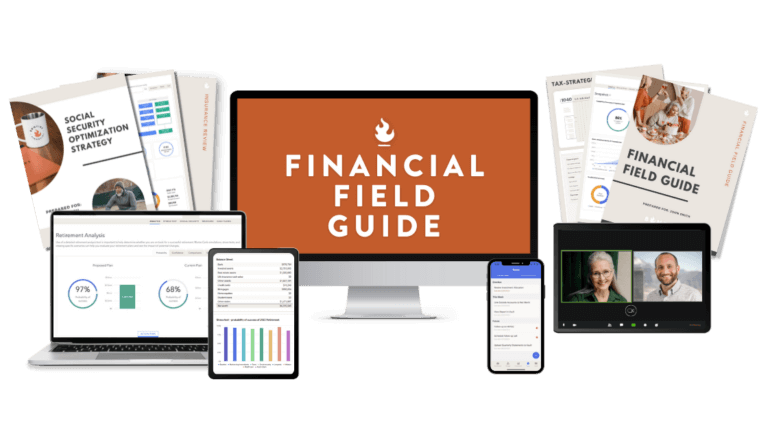Rebalancing isn’t the most exciting part of investing. It’s not something you’ll see on the news ticker or in a flashy headline. Yet for people preparing for or living in retirement, it may be one of the most important strategies you can use to protect your wealth.
At its core, rebalancing is about discipline. Markets move in unpredictable ways, and over time, those swings shift the mix of investments in your portfolio. Without even realizing it, you may be taking on more risk than you intended or missing out on growth opportunities. Rebalancing realigns your investments with your goals, helping you stay the course through both bull and bear markets.
Today, we’ll break down what rebalancing is, why it matters, and how to put it into practice. You’ll see how it can make a meaningful difference in reaching your long-term retirement goals.
Listen Now: iTunes | Spotify | iHeartRadio | Amazon Music
What Is Portfolio Rebalancing?
Portfolio rebalancing is the process of realigning the weightings of your investments back to your target allocation.
Let’s say you’ve decided that a 50/50 mix of stocks and bonds is the right balance for you. Over time, the stock market rises, and your portfolio drifts to 60% stocks and 40% bonds. That might feel good in the moment, your account balance is up, but you’re now taking on more risk than you originally planned.
Rebalancing means selling a portion of your stocks (while they’re high) and shifting that money back into bonds, restoring your portfolio to the original 50/50 balance.
On the flip side, if the stock market falls and your portfolio drifts to 40% stocks and 60% bonds, rebalancing means selling some of the bonds and buying stocks while they’re low. This ensures you’re not underexposed to future growth when the market eventually recovers.
Equities vs. Fixed Income: The Two Buckets
To understand rebalancing, it helps to break investing down into two simple buckets:
-
Equities (stocks): “Risk-on” investments that represent ownership in companies. You’re aiming for growth through capital appreciation and dividends.
-
Fixed Income (bonds, CDs, treasuries): “Risk-off” investments that provide more predictable income. Think of it like a mortgage where you are the bank: you lend money to a government or corporation, and they promise to pay you back with interest.
Stocks typically offer higher potential returns, but with higher volatility. Bonds are generally steadier, though still subject to risks like interest rate changes.
Your personal mix of these two buckets is your asset allocation, the foundation of your investment strategy.
Diversification and Asset Allocation
Diversification is one of the cornerstones of preserving wealth. Instead of putting all your eggs in one basket, you spread your money across different asset classes so no single investment can sink your plan.
Asset allocation, how much you hold in stocks versus bonds, is the most important part of diversification. But here’s the key: there is no one-size-fits-all rule.
-
The old “age minus 100” rule for bond allocation doesn’t capture the full picture.
-
Two investors at the same age can have very different goals, risk tolerances, and time horizons.
-
Asset allocation is more art than science, it requires tailoring to your situation.
A skilled advisor helps you determine your target allocation by balancing your need for growth, your comfort with risk, and your long-term retirement goals.
How Portfolios Drift Over Time
Here’s where rebalancing comes into play: markets move, and with them, so does your portfolio.
Bull markets: Stocks rise faster than bonds. A 50/50 portfolio can quickly drift to 60/40 or 70/30. Without adjusting, you’re carrying more risk than you intended.
Bear markets: Stocks fall faster than bonds. That same 50/50 portfolio could shrink to 40/60. Without rebalancing, you may miss the rebound when the market recovers.
This drift happens quietly. You don’t get an alert from your custodian that says, “Congratulations, you’re now riskier than you wanted to be!” Yet the impact is real.
Why Rebalancing Is So Important
Rebalancing matters because it keeps your investments aligned with your risk tolerance and your plan. Without it, you might find yourself:
-
Taking on more risk than you can stomach in a downturn.
-
Missing out on growth opportunities when markets recover.
-
Falling into emotional traps like “letting it ride” when things are good or “selling everything” when things are bad.
Rebalancing forces you to buy low and sell high, even when your emotions are telling you to do the opposite.
Lessons from 2008
During the Great Recession, markets fell more than 50%. Investors who were overweight in equities, often without realizing it, saw their portfolios drop more than expected. Many panicked, sold out at the bottom, and missed the recovery that followed.
Investors who stuck with their plan and rebalanced were positioned to capture that recovery, often coming out stronger in the long run.
The Psychology Behind Rebalancing
Investing is as much about behavior as it is about numbers.
Every investor has what we call a capitulation point, the point where fear takes over and they say, “Get me out, I can’t take this anymore.” That’s usually the worst possible time to sell.
Rebalancing helps prevent reaching that point by keeping your portfolio in line with your comfort zone. It creates discipline in an area where emotions run high.
And it reinforces one of the most important investing truths: time in the market is more important than timing the market.
Practical Ways to Rebalance
There are a few different ways to approach rebalancing:
-
Calendar-based: Review once a year (often at year-end for tax planning). Adjust if allocations are significantly out of line.
-
Threshold-based: Only rebalance when allocations drift more than 5–10% from target.
-
Automated: Many 401(k)s and IRAs allow you to set automatic annual rebalancing. This “set it and forget it” method helps remove emotion.
For most investors, once a year is plenty. Rebalancing too often (monthly or quarterly) can generate unnecessary costs and prevent your portfolio from capturing natural market momentum.
Common Mistakes to Avoid
-
Over-rebalancing
Moving things around too often just for the sake of it can create extra taxes and fees. -
Ignoring changes in risk tolerance
Your ideal allocation may shift as you near retirement or as your goals evolve. Rebalancing should align with your life, not just the markets. -
Relying on rules of thumb
Cookie-cutter advice doesn’t work. A 65-year-old who plans to work part-time for 10 more years doesn’t need the same allocation as a 65-year-old who just retired.
Rebalancing in Action: Scenarios
-
Scenario 1: Bull Market Drift
A 50/50 portfolio drifts to 65/35 after a strong market run. The investor rebalances back to 50/50, locking in gains and reducing exposure before a downturn. -
Scenario 2: Bear Market Recovery
A 60/40 portfolio drifts to 40/60 during a market drop. The investor sells bonds and buys stocks at low prices, setting the stage for a stronger recovery. -
Scenario 3: Retirement Income Needs
A retiree relying on bond income notices their stock allocation has crept higher. Rebalancing restores their comfort level, keeping income reliable.
Rebalancing as Part of the Bigger Picture
Rebalancing isn’t a one-off tactic; it’s part of a bigger strategy. It works best when tied to:
-
A comprehensive retirement plan
-
Ongoing conversations about goals and risk tolerance
-
Tax planning (especially in taxable accounts)
-
Guidance from an experienced fiduciary advisor
It’s not about reacting to headlines or chasing returns. It’s about staying consistent with the plan you’ve built for your future.
Conclusion
Rebalancing may not be glamorous, but it’s one of the smartest ways to stay in control of your wealth. It helps you manage risk, avoid emotional mistakes, and stay aligned with your long-term goals, especially in retirement, when stability matters most.
At Bonfire Financial, we believe disciplined strategies like rebalancing are key to giving our clients confidence through all market conditions.
Ready to make sure your portfolio is aligned with your goals?
Schedule a call with our team today. We’ll review your allocation, talk through your retirement plan, and help ensure you’re on track for long-term success.
 Client Login
Client Login







